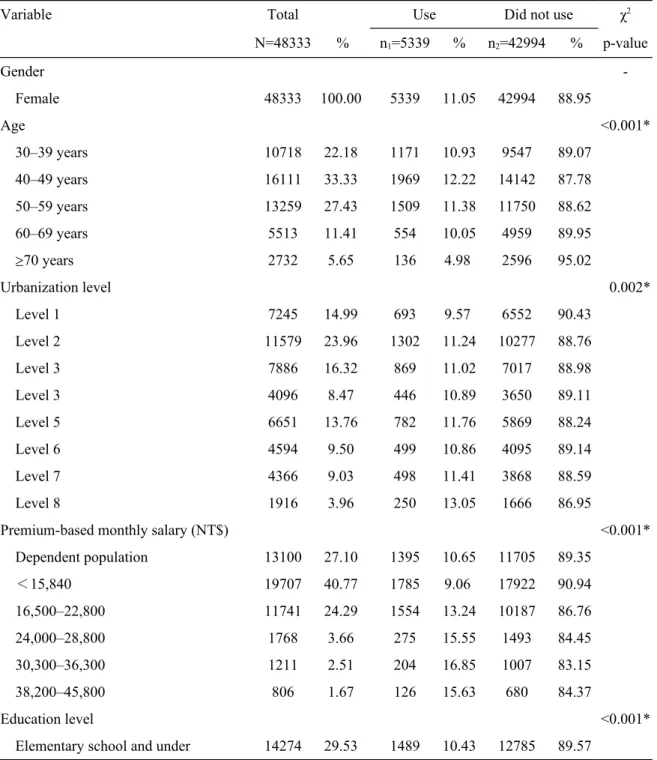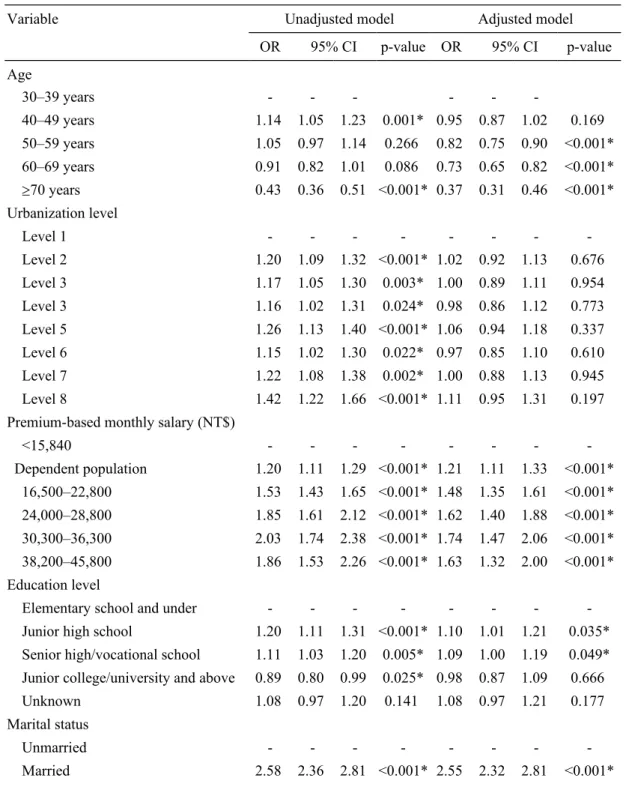Full title:
Sociodemographic characteristics and health-related factors affecting the use of Pap smear screening among women with mental disabilities in Taiwan
Short title:
Pap smear screening among mental disabilities
Suh-May Yen
1, 2Pei-Tseng Kung
3,#Wen-Chen Tsai
1,#,*1. Department of Health Services Administration, China Medical University, Taichung, Taiwan, R.O.C.
2. Department of Chinese Medicine, Nantou Hospital, Nantou, Taiwan, R.O.C.
3. Department of Healthcare Administration, Asia University, Taichung, Taiwan, R.O.C.
Suh-May Yen: suhmayyen@yahoo.com.tw Pei-Tseng Kung: ptkung@asia.edu.tw Wen-Chen Tsai: wtsai@mail.cmu.edu.tw
#
Authors had equal contribution to this work.
*Correspondence author:Professor Wen-Chen Tsai, Dr.PH
Address:No. 91 Hsueh-Shih Road, Taichung, Taiwan 40402, R.O.C
Tel:886-4-22073070
Fax:886-4-22028895
E-mail: wtsai@mail.cmu.edu.tw
Abstract
Objectives: This study examined the use of the Pap cervical cancer screening test
among women with mental disabilities in Taiwan and analyzed related factors.
Methods: Data were obtained from three national databases in Taiwan: the 2008 database of physically and mentally disabled persons from the Ministry of the Interior, 2007–2008 Pap smear test data from the Health Promotion Administration, and claims data from the National Health Insurance Research Database. The study subjects included 49,642 Taiwanese women aged 30 years with mental disabilities. Besides descriptive and bivariate analyses, logistic regression analysis was also performed to
examine factors affecting Pap smear use.
Results: In 2007–2008, Taiwanese women with mental disabilities had a Pap screening rate of 11.05%. Age, income, education, marital status, catastrophic illness/injury, relevant chronic illnesses, and severity of disability were identified as factors affecting their Pap smear use. Age and severity of disability were negatively correlated with Pap screening, with the odds of screening being 0.37 times as high in 70-year-olds as in 30–39-year-olds and 0.49 times as high for very severe disability as for mild disability.
Income was positively correlated with Pap screening. Being married (OR=2.55) or
divorced or widowed (OR=2.40) relative to being unmarried, and having a catastrophic
illness/injury (OR=1.13), cancer (OR=1.47), or diabetes (OR=1.25), were associated
with greater odds of screening.
Conclusions: In Taiwan, women with mental disabilities receive Pap smears at a far lower rate than women in general.
Key Words : mental disability; Pap smear Test; Screening test; Cancer prevention
Introduction
Cervical cancer is among the top ten most common cancers in women worldwide,
with over 85% of the cases occurring in developing countries
1. The Pap smear test for
cervical cancer screening has been recognized as a highly effective preventive measure,
and its systematic use has reduced cervical cancer mortality by an estimated 70% in
developed countries
2. In Taiwan, the National Health Insurance program has provided
free annual Pap screening to women 30 years and older since 1995, and has successfully reduced the age-adjusted annual mortality rate for cervical cancer from 10.5 to 3.9 per 100,000 population from 1996 to 2012
3. A similar downward trend has been observed in other countries. In Canada, cervical cancer mortality decreased from 13.5 to 2.2 per 100,000 populations per year from 1952 to 2006
4; in England and Wales, cervical cancer mortality fell by 4.6% per year between 1988 and 2001
5. Previous studies in Taiwan found the use of the Pap screening service to be affected by such factors as women’s age, income, health status, area of residence
6, marital status, education level,
7

